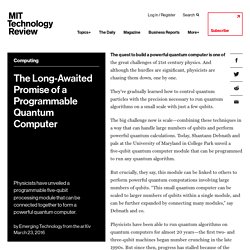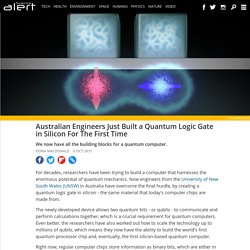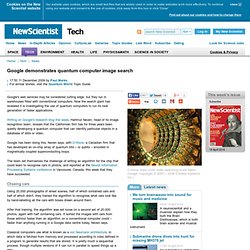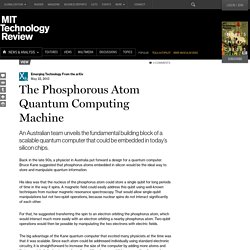

Microsoft’s Quantum Mechanics. In 2012, physicists in the Netherlands announced a discovery in particle physics that started chatter about a Nobel Prize.

Inside a tiny rod of semiconductor crystal chilled cooler than outer space, they had caught the first glimpse of a strange particle called the Majorana fermion, finally confirming a prediction made in 1937. It was an advance seemingly unrelated to the challenges of selling office productivity software or competing with Amazon in cloud computing, but Craig Mundie, then heading Microsoft’s technology and research strategy, was delighted. The abstruse discovery—partly underwritten by Microsoft—was crucial to a project at the company aimed at making it possible to build immensely powerful computers that crunch data using quantum physics. “It was a pivotal moment,” says Mundie.
“This research was guiding us toward a way of realizing one of these systems.” Microsoft is now almost a decade into that project and has just begun to talk publicly about it. The Long-Awaited Promise of a Programmable Quantum Computer. Physicists have unveiled a programmable five-qubit processing module that can be connected together to form a powerful quantum computer.

The quest to build a powerful quantum computer is one of the great challenges of 21st century physics. And although the hurdles are significant, physicists are chasing them down, one by one. They’ve gradually learned how to control quantum particles with the precision necessary to run quantum algorithms on a small scale with just a few qubits. Australian engineers just built a quantum logic gate in silicon for the first time. For decades, researchers have been trying to build a computer that harnesses the enormous potential of quantum mechanics.

Now engineers from the University of New South Wales (UNSW) in Australia have overcome the final hurdle, by creating a quantum logic gate in silicon - the same material that today's computer chips are made from. The newly developed device allows two quantum bits - or qubits - to communicate and perform calculations together, which is a crucial requirement for quantum computers.
Even better, the researchers have also worked out how to scale the technology up to millions of qubits, which means they now have the ability to build the world's first quantum processor chip and, eventually, the first silicon-based quantum computer. Right now, regular computer chips store information as binary bits, which are either in a 0 or 1 state.
This system works well, but it means that there's a finite amount of data that can be processed. Institute for Quantum Computing — IQC.ca. Google demonstrates quantum computer image search - tech - 11 December 2009. Google's web services may be considered cutting edge, but they run in warehouses filled with conventional computers.

Now the search giant has revealed it is investigating the use of quantum computers to run its next generation of faster applications. Writing on Google's research blog this week, Hartmut Neven, head of its image recognition team, reveals that the Californian firm has for three years been quietly developing a quantum computer that can identify particular objects in a database of stills or video. Google has been doing this, Neven says, with D-Wave, a Canadian firm that has developed an on-chip array of quantum bits – or qubits – encoded in magnetically coupled superconducting loops. The team set themselves the challenge of writing an algorithm for the chip that could learn to recognise cars in photos, and reported at the Neural Information Processing Systems conference in Vancouver, Canada, this week that they have succeeded. Chasing cars. A first look inside Google's futuristic quantum lab.
In May, Google launched the Quantum Artificial Intelligence Lab with hardware from the Canadian quantum computing company D-Wave and technical expertise from NASA.

It was an ambitious open research project aimed at exploring both the capabilities of quantum computer architecture and the mysteries of space exploration — but in the months since, they've stayed quiet about exactly what kind of work they've been doing there. Operated at near-absolute-zero temperatures Tomorrow, they're breaking the silence with a brief short film, set to debut at the Imagine Science Films Festival at Google New York.
The film takes a look at various researchers working on the project, as well as the computer itself, which has to be operated at near-absolute-zero temperatures. Researchers hope the quantum architecture will eventually be used to optimize solutions across complex and interconnected sets of variables currently outside the capabilities of conventional computing. Google and NASA ride D-Wave to a quantum future - tech - 03 December 2014. Read full article Continue reading page |1|2 A New Scientist investigation reveals Google's grand plans for its quantum computer, as well as the first hints about what's really going on under its hood THEY could be the most powerful computers in the world – so perhaps it's no surprise that the biggest internet company on the planet is testing one out.

Last year Google purchased a quantum computer from D-Wave Systems in British Columbia, Canada, currently the only firm claiming to sell chips powered by exotic physics. However, this claim is controversial; some say D-Wave has yet to fully demonstrate its chips' quantum capabilities. In theory, quantum computers offer a huge advantage over ordinary PCs. IBM's Quantum Computers Could Change The World (Mostly In Very Good Ways) 101010: That's the number 42 represented in binary, which is the mathematical way today's binary computers see every single piece of information flowing through them, whether it's a stock price, the latest Adele track, or a calculation to generate an MRI of a tumor.

But now IBM believes it's made progress in developing quantum computers, which don't use binary coding. It is not overstating the matter to say this really may be the ultimate answer in computing machines. Quick, mop your brow and don't worry: The science isn't too hard to grasp and the revolution, when it comes, could rock the world. In a very good way. First, a little background: Computers today, everything from the chip controlling your washing machine cycle to the screen you're reading this on, rely on binary math to work. Now, what if instead of simply being able to do math with ones and zeros, a computer chip could work with bits that included other numbers?
Commercial quantum computer leaves PC in the dust - physics-math - 10 May 2013. For the first time, a commercially available quantum computer has been pitted against an ordinary PC – and the quantum device left the regular machine in the dust.

D-Wave, a company based in Burnaby, Canada, has been selling quantum computers since 2011, although critics expressed doubt that their chips were actually harnessing the spooky action of quantum mechanics. That's because they use a non-mainstream method called adiabatic quantum computing. Unlike classical bits, quantum bits, or qubits, can take the values 0 and 1 at the same time, theoretically offering much faster computing speed. Quantum Or Not, New Supercomputer Is Certainly Something Else. It's exactly the sort of futuristic thinking you'd expect from Google and NASA: Late last week, the organizations announced a partnership to build a Quantum Artificial Intelligence Lab at NASA's Ames Research Center.

But questions surround the new type of computer at the lab's core. The Phosphorous Atom Quantum Computing Machine. Back in the late 90s, a physicist in Australia put forward a design for a quantum computer.

Bruce Kane suggested that phosphorus atoms embedded in silicon would be the ideal way to store and manipulate quantum information. His idea was that the nucleus of the phosphorus atom could store a single qubit for long periods of time in the way it spins. A magnetic field could easily address this qubit using well-known techniques from nuclear magnetic resonance spectroscopy. That would allow single-qubit manipulations but not two-qubit operations, because nuclear spins do not interact significantly of each other.
For that, he suggested transferring the spin to an electron orbiting the phosphorus atom, which would interact much more easily with an electron orbiting a nearby phosphorus atom. Icists show self-correcting quantum computers are theoretically possible. (Phys.org) —Using exotic components such as color codes, new phases of quantum matter, and extra dimensions, a team of physicists has shown that it's theoretically possible to construct a quantum computer that has the ability to correct itself whenever an error occurs. "The greatest significance of our work is showing that self-correcting quantum computing at a finite temperature is not impossible as a matter of principle," physicist Héctor Bombin told Phys.org.
Bombin was at MIT in Cambridge, Massachusetts, while performing the study and is currently at the Perimeter Institute in Waterloo, Ontario. "In fact, the original motivation came from claims to the contrary by other authors. We provide explicit constructions that can be checked directly, without numerical simulations. " Bombin and his coauthors have published a paper on their proposed self-correcting quantum computer in a recent issue of the New Journal of Physics. More information: H. Google Tests First Error Correction in Quantum Computing. Quantum Computer. Quantum Computers Animated. How Does a Quantum Computer Work? Why would quantum computers be so much faster than classical computers? Microsoft’s Strange Quest for the Topological Qubit. In 2012, physicists in the Netherlands announced a discovery in particle physics that started chatter about a Nobel Prize. Inside a tiny rod of semiconductor crystal chilled cooler than outer space, they had caught the first glimpse of a strange particle called the Majorana fermion, finally confirming a prediction made in 1937.
It was an advance seemingly unrelated to the challenges of selling office productivity software or competing with Amazon in cloud computing, but Craig Mundie, then heading Microsoft’s technology and research strategy, was delighted. The abstruse discovery—partly underwritten by Microsoft—was crucial to a project at the company aimed at making it possible to build immensely powerful computers that crunch data using quantum physics. “It was a pivotal moment,” says Mundie. “This research was guiding us toward a way of realizing one of these systems.” Microsoft is now almost a decade into that project and has just begun to talk publicly about it. Tied Up in Knots. Ivan Deutsch Interview on Quantum Computers. For more than 20 years, Ivan H. Deutsch has struggled to design the guts of a working quantum computer. He has not been alone.